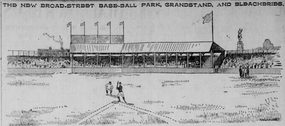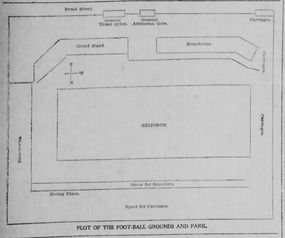The 1897 Richmond Spiders football team was an American football team that represented Richmond College—now known as the University of Richmond—as an independent during the 1897 college football season. Led by Bill Wertenbaker in his first and only year as head coach, Richmond compiled a record of 3–5.
The 1905 Richmond Spiders football team was an American football team that represented Richmond College—now known as the University of Richmond—as a member of the Eastern Virginia Intercollegiate Athletic Association (EVIAA) during the 1905 college football season. Led by first-year head coach E. A. Dunlap, Richmond compiled a record of 3–5–2.
The 1908 Richmond Spiders football team was an American football team that represented Richmond College—now known as the University of Richmond—as a member of the Eastern Virginia Intercollegiate Athletic Association (EVIAA) during the 1908 college football season. Led by fourth-year head coach E. A. Dunlap, Richmond compiled a record of 3–5.
The 1911 Richmond Spiders football team was an American football team that represented Richmond College—now known as the University of Richmond—as a member of the Eastern Virginia Intercollegiate Athletic Association (EVIAA) during the 1911 college football season. Led by Sam Honaker in his first and only year as head coach, compiled an overall record of 0–6–2 with a mark of 0–3 in conference play, placing last out of four teams in the EVIAA.
The 1910 Richmond Spiders football team was an American football team that represented Richmond College—now known as the University of Richmond—as a member of the Eastern Virginia Intercollegiate Athletic Association (EVIAA) during the 1910 college football season. Led by E. V. Long in his first and only year as head coach, Richmond finished the season 1–6–1.
The 1912 Richmond Spiders football team was an American football team that represented Richmond College—now known as the University of Richmond—as a member of the Eastern Virginia Intercollegiate Athletic Association (EVIAA) during the 1912 college football season. Led by E. A. Dunlap in his sixth and final year as head coach, Richmond Richmond compiled an overall record of 1–7 with a mark of 1–2 in conference play, placing third in the EVIAA.
The 1913 Richmond Spiders football team was an American football team that represented Richmond College—now known as the University of Richmond—as a member of the Eastern Virginia Intercollegiate Athletic Association (EVIAA) during the 1913 college football season. Led by first-year head coach Frank Dobson, Richmond compiled an overall record of 5–3–1 with a mark of 3–0 in conference play, winning the EVIAA title.
The 1914 Richmond Spiders football team was an American football team that represented Richmond College—now known as the University of Richmond—as a member of the Eastern Virginia Intercollegiate Athletic Association (EVIAA) and the South Atlantic Intercollegiate Athletic Association (SAIAA) during the 1914 college football season. Led by second-year head coach Frank Dobson, Richmond finished the season 5–4 overall, 5–1 in EVIAA play, and 0–2 against SAIAA opponents. The Spiders won the EVIAA title for the second consecutive year.
The 1916 Richmond Spiders football team was an American football team that represented Richmond College—now known as the University of Richmond—as a member of the Eastern Virginia Intercollegiate Athletic Association (EVIAA) and the South Atlantic Intercollegiate Athletic Association (SAIAA) during the 1916 college football season. Led by fourth-year head coach Frank Dobson, Richmond finished the season 5–4–2 overall, 4–1–2 in EVIAA play, and 1–3–1 against SAIAA opponents. The Spiders tied with Hampden–Sydney for the EVIAA title.
The 1917 Richmond Spiders football team was an American football team that represented Richmond College—now known as the University of Richmond—as a member of the Eastern Virginia Intercollegiate Athletic Association (EVIAA) and the South Atlantic Intercollegiate Athletic Association (SAIAA) during the 1917 college football season. Led by fifth-year head coach Frank Dobson, Richmond finished the season 4–2–1 overall, 4–1–1 in EVIAA play, and 2–1 against SAIAA opponents.
The 1921 Richmond Spiders football team was an American football team that represented the University of Richmond as a member of the South Atlantic Intercollegiate Athletic Association (SAIAA) during the 1921 college football season. Led by eighth-year head coach, Frank Dobson, Richmond compiled an overall record of 4–3–1 with a mark of 2–2–1 in conference play. 1921 was the team's final season in the SAIAA.
The 1925 Richmond Spiders football team was an American football team that represented the University of Richmond as an independent during the 1925 college football season. Led by 12th-year head coach, Frank Dobson, the Spiders compiled a record of 3–6. Richmond played their home games at Mayo Island Park on Mayo Island.
The 1926 Richmond Spiders football team was an American football team that represented the University of Richmond as an independent during the 1926 college football season. Led by 13th-year head coach, Frank Dobson, the Spiders compiled a record of 2–7. Joe DeMotte played for Richmond. Richmond played their home games at Tate Field on Mayo Island.
The 1927 Richmond Spiders football team was an American football team that represented the University of Richmond as a member of the Virginia Conference during the 1927 college football season. Led by 14th-year head coach, Frank Dobson, Richmond compiled an overall record of 4–4–1. The team opened the season with a starting lineup at an average weight of just 162 pounds. Richmond played their home games at Tate Field on Mayo Island.
The 1928 Richmond Spiders football team was an American football team that represented the University of Richmond as a member of the Virginia Conference during the 1928 college football season. Led by 15th-year head coach, Frank Dobson, Richmond compiled an overall record of 3–4–2. The team included Herbie Peterson, whom Dobson considered one of the three best backs he ever coached. Richmond played their home games at Tate Field on Mayo Island.
The 1929 Richmond Spiders football team was an American football team that represented the University of Richmond as a member of the Virginia Conference during the 1929 college football season. Led by 16th-year head coach, Frank Dobson, Richmond compiled an overall record of 3–5–1. City Stadium opened as Richmond's new home field.
The 1911 North Carolina Tar Heels football team represented the University of North Carolina in the 1911 college football season. The team captain of the 1911 season was Bob Winston.
Tate Field, known as Island Park in the 1890s and Mayo Island Park prior to 1926, was a stadium located on Mayo Island in the James River within the city of Richmond, Virginia. It hosted sporting events including college football and Minor League Baseball. Tate Field served as the home field for the Richmond Colts of the Virginia League, Eastern League, and Piedmont League from 1921 to 1941 and the Richmond Spiders football team of the University of Richmond from 1925 to 1928.
The Richmond Bluebirds were a minor league baseball team based in Richmond, Virginia. Between 1895 and 1901, the Bluebirds played as members of the Virginia League in 1895 and 1896, Atlantic League from 1897 to 1899, Virginia League in 1900 and Virginia-North Carolina League in 1901. The Bluebirds won league championships in 1895, 1896, 1898 and 1899, all while playing under manager Jake Wells.
The 1934 VMI Keydets football team was an American football team that represented the Virginia Military Institute (VMI) during the 1934 college football season as a member of the Southern Conference. In their eighth year under head coach W. C. Raftery, the team compiled an overall record of 1–8.

